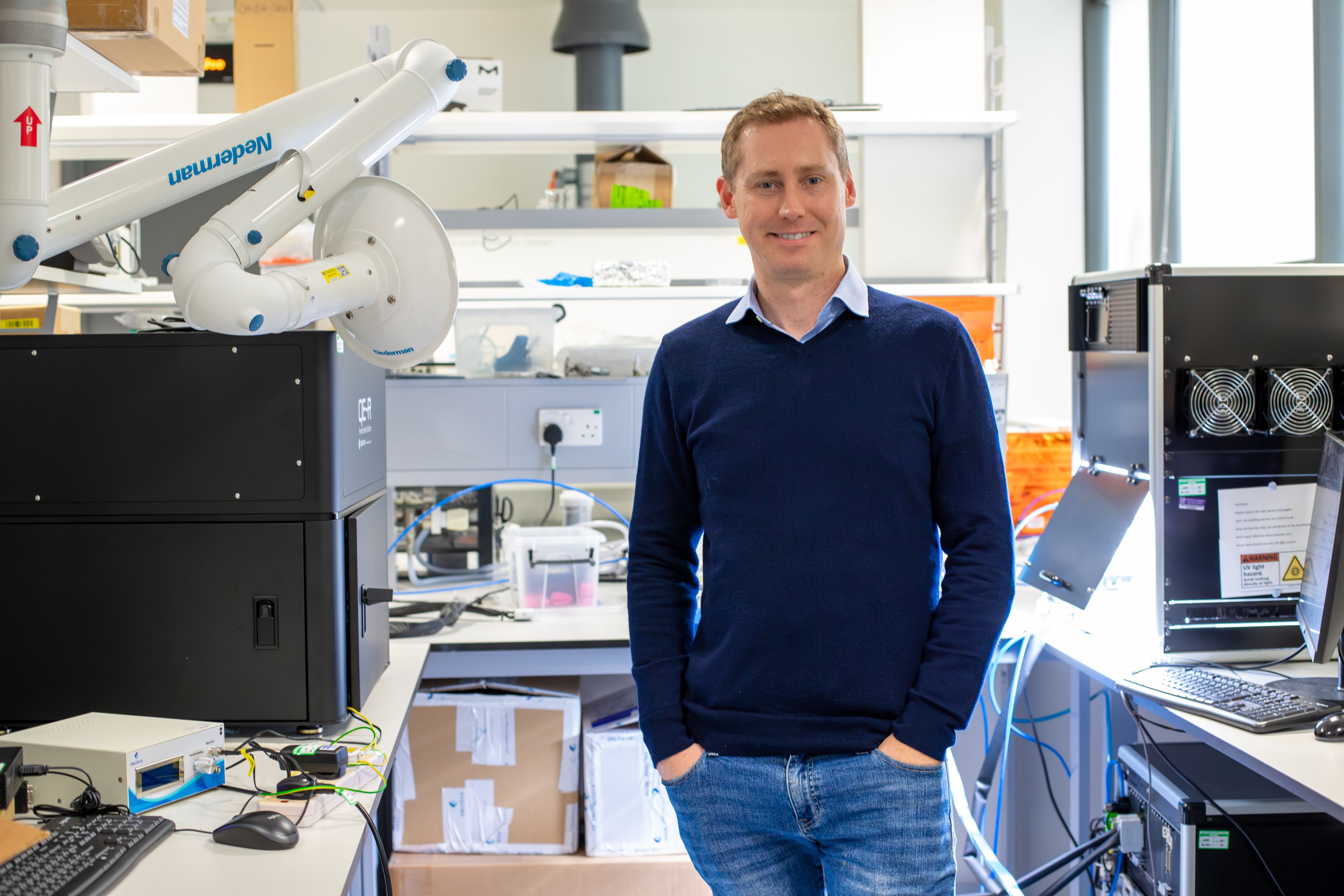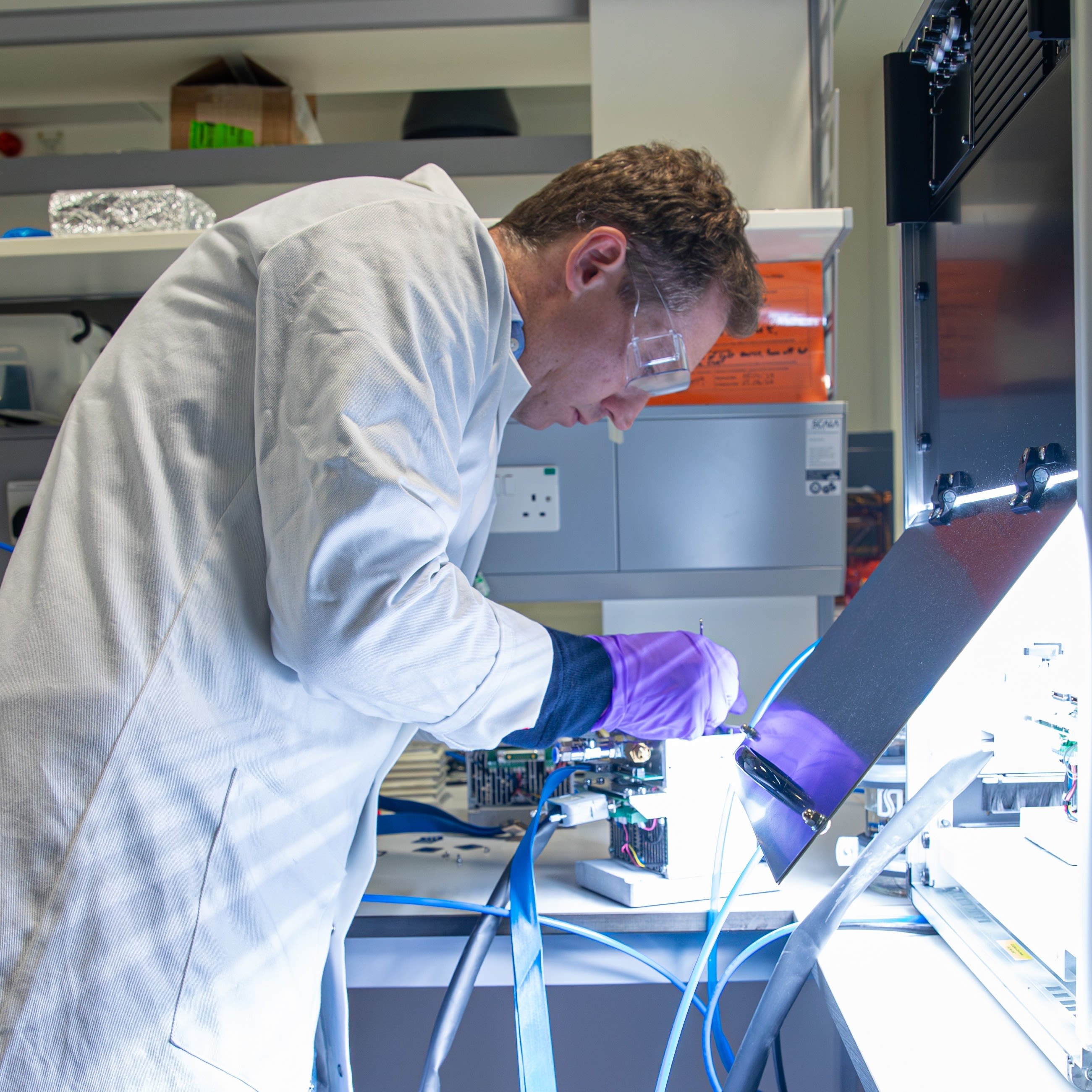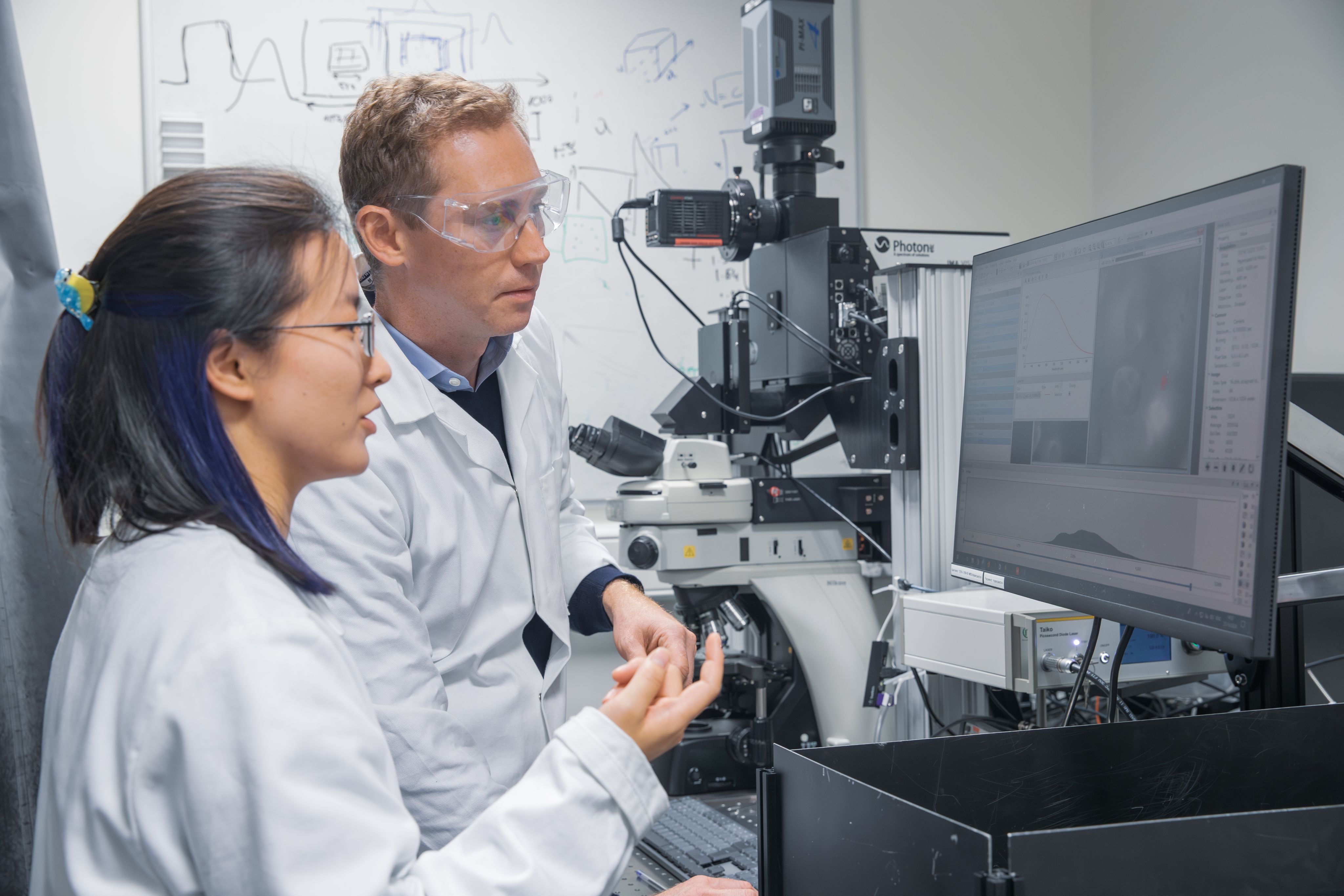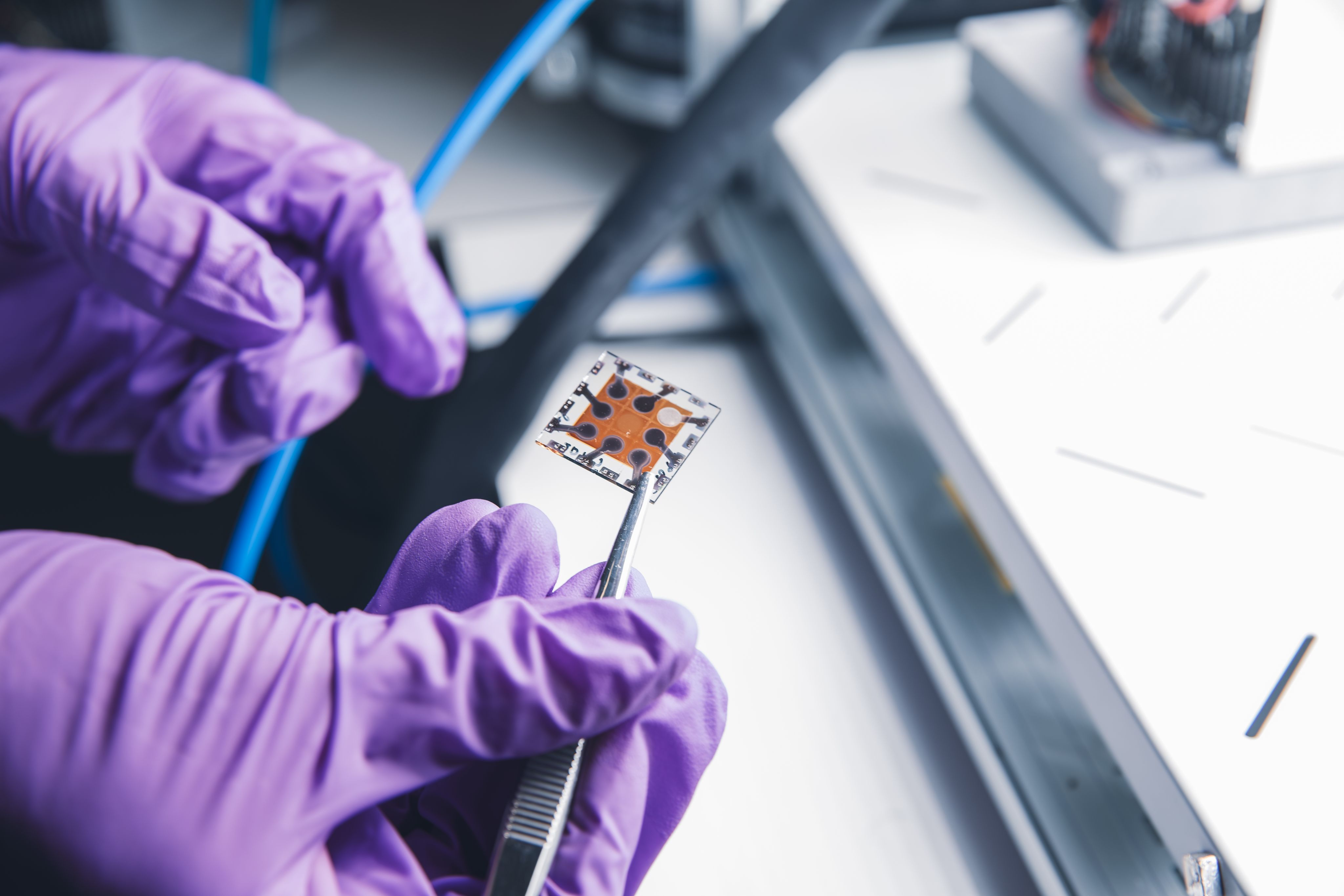Shaping the future of energy
An interview with Clare Fellow, Professor Sam Stranks



Sam Stranks is a Fellow of Clare, Professor of Energy Materials and Optoelectronics at the University of Cambridge and a leading figure in the field of renewable energy and photovoltaics. Clare News had the opportunity to sit down with him to discuss his groundbreaking research and his commitment to creating a greener, more sustainable world.
I am fortunate to lead such an energetic and diverse research group all working hard to do our bit towards these global challenges.
Can you tell us a little bit about your background, what inspired you to pursue a career in scientific research and academia?
I am from Adelaide, Australia where I did my undergraduate studies in physics, chemistry (BSc) and maths and German studies (BA). A unique mix! But this set the scene for my career working at the interface between different disciplines. My first foray into research was in fact focusing on modelling proteins aggregating in white wine, a large problem for the wine industry – a project crossing between physics, mathematics, chemistry and biology. I was fortunate enough to receive a Rhodes Scholarship to undertake my DPhil (PhD) at Oxford, where I turned my focus to renewable energy – working on emerging photovoltaic materials. I see climate change as one of humanity’s biggest challenges and so working on solutions to this problem whilst working on a rich science problem was a perfect mix.
Your primary area of research focuses on perovskites. Could you explain what they are and their potential applications?
After finishing my PhD, I was elected as a Junior Research Fellow at Worcester College, Oxford, where I started in Henry Snaith’s lab where they were trying out new materials for solar cells. Serendipitously, just at the time I joined, there was a discovery that a material called halide perovskites showed very promising performance as a solar cell –and I turned my focus to them to investigate their properties and what makes them a good solar cell material, and how we could improve them further. I was proud that this led to a number of important discoveries at an exciting time in the early stages of the field.
Perovskites represent a huge family of materials as they are anything that takes the ABX3 crystal structure, and there are many naturally occurring perovskite minerals. However, the particular perovskites useful for applications such as solar cells are metal halide variants made in the lab, and their composition can be tuned to allow them to absorb light very well and also transport energised electrons well (whilst most perovskite minerals do not have these properties). We can make films of these metal halide perovskites by dissolving organic and inorganic salts in solvents to make inks that we can then cast down easily. What is remarkable is that they can be processed quite crudely (i.e. easily) yet are able to perform as well as some of the best
established semiconductors such as silicon. This really opens up a new world of tuneable, inexpensive semiconductors for a variety of applications including solar that can push efficiencies beyond traditional silicon solar cells.
One of the most exciting applications is by
layering multiple perovskite cells together, or on top of silicon, to produce multijunction cells with very high efficiency – imagine a solar array with the same number of modules but producing even 50% more power. As they can be processed at low temperature, they can be made flexible and lightweight, making high-performance solar spools that could be rolled out more easily (and cheaply) on a rooftop, space and aerial vehicles, and for boosting the range for electric vehicles. Other applications include LEDs for next-generation displays and white lighting and – something I am very excited about – low dose medical X-ray imaging detectors that could enable early stage disease detection and screening.
Perovskite solar cells are often discussed as a cheaper and more efficient alternative to traditional silicon-based panels. Do you believe they have the potential for widespread global adoption?
Yes I am optimistic about their future. Efficiencies in the lab are already matching silicon solar cells, and multijunction cells are already well surpassing silicon efficiencies. A key challenge is to make sure we can do this at larger scale – pushing centremetre size cells to metre size modules, though there is already some very promising academic and industrial work on this, with full modules already being made in Germany and in China and the first products sold. Another key challenge is making sure they can last on a rooftop for decades. This requires accelerated lifetime testing of continuous operation under light and elevated temperature, though such tests are still not a perfect substitute for outdoor field testing (which is only in earlier stages).
The most recent data shows they already last around 5 years under strenuous conditions, but longer data is still pending. There are still persisting issues around performance degradation over long periods of operation, meaning there is still materials R&D on the perovskite layer and other device layers to improve this further. I believe these are solvable issues within the next 2-3 years and we will see widespread commercialisation over the next 5 years.
You’re also co-founder of the start-up Swift Solar, named as one of America’s top 20 Green Tech companies in 2024, congratulations! What inspired you to start the company and what impact do you hope it will have on renewable energy?
I’m very excited about this venture. In 2017, my co-founders and I had exciting ideas about how we could take the perovskite solar technology to large scale especially using multifunction approaches, and we have now grown the company to around 50 employees and raised $60M to develop the technology. I enjoy academic work but also am inspired to take it to real world applications. The entrepreneurial world has been a steep but fruitful learning curve!
More recently, we have launched a new startup from our lab, Clarity Sensors, commercialising X-ray detectors for low- dose medical imaging, and I am excited about their potential impact on early disease detection such as cancer and heart disease.
What do you enjoy most about
working with students, both in
the lab and in the classroom?
Their enthusiasm and ideas are so inspiring. I am fortunate to lead such an energetic and diverse research group all working hard to do our bit towards these global challenges. It is also inspiring teaching our undergraduate students in the classroom, who also have a passion for their subject and what can be done with it.

As if that wasn’t enough, you are also co-founder of Sustain/ Ed. A not-for-profit organisation providing climate focussed teaching resources for primary schools. How did you become involved in this and what impact do you hope it will have?
Sustain/Ed was founded together with two of my former group members. During their time in the group, we had many discussions about how climate change is taught in schools. We were awarded a small grant from the University Impact Accelerate Award (IAA) to develop teaching modules, together with teachers, that teach and inspire primary school students that there is hope and there are things they can do to help to solve this problem. The materials are free and available online for all teachers to use and freely adapt. We have scaled to around 20 schools and hope it can scale more widely over the coming years – this would have a huge impact by inspiring the next generation.
When it comes to addressing climate change, there’s so much to consider. If you could encourage people to focus on just one key action or change, what would it be and why?”
We need to have a mindset change from governments and people that the future is green energy, and it is also good business! Now more than ever we can’t let the hard work towards greening society’s energy use slow down, as there is just so much at stake for our futures.
